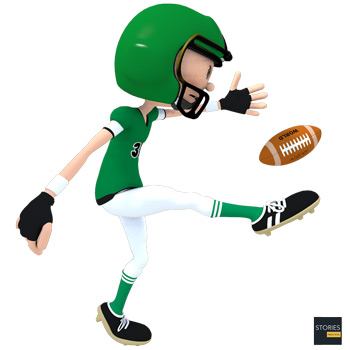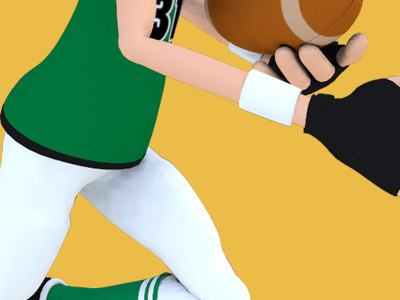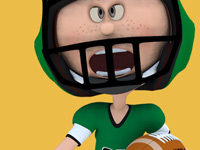American football

Placekicker, or simply kicker (PK or K)
Placekicker, or simply kicker (PK or K), is the player in American and Canadian football who is responsible for the kicking duties of field goals and extra points. In many cases, the placekicker also serves as the team's kickoff specialist or punter as well.
Specialized role of kicker (versus punter)
The kicker initially was not a specialized role. Prior to the 1934 standardization of the prolate spheroid shape of the ball, drop kicking was the prevalent method of kicking field goals and conversions, but even after its replacement by place kicking, until the 1960s the kicker almost always doubled at another position on the roster. George Blanda, Frank Gifford and Paul Hornung are prominent examples of players who were stars at other positions as well as being known for their kicking abilities. When the one-platoon system was abolished in the 1940s, the era of "two-way" players gave way to increased specialization, teams would employ a specialist at the punter or kicker position. Ben Agajanian, who started his professional career in 1945, was the first confirmed place-kicking specialist in the NFL, kicking for ten teams. (There is some evidence that Ken Strong and Phil Martinovich, both in 1939, and Mose Kelsch, in 1933 and 1934, may have preceded Agajanian as players who spent their seasons doing nothing but kicking.)

Because of the difference in techniques needed, to avoid leg fatigue, and to reduce the risk of injury, on the professional level most teams employ separate players to handle the jobs. The placekicker usually will only punt when the punter is injured, and vice versa. (One player often handles both jobs in the Canadian Football League, which has smaller active rosters than in the NFL.) A professional team will occasionally even have a "kickoff specialist" who handles only the kickoffs and serves as a backup to the kicker who handles field goals and extra points. This is typically done to further protect a premier point-scoring kicker from injury or if he, while accurate, does not have sufficient distance on kickoffs.
Amateur teams (e.g., college or high school) often do not differentiate between placekickers and punters, have different players assume different placekicking duties (for example, one person handles kicking off, another kicks long field goals, and another kicks from shorter distances), or have regular position players handle kicking duties. The last option is quite common on high school teams, when the best athletes are often the best kickers. Before the modern era of pro football, this was also the case for professional teams, particularly when most placekicks were still made in the "straight on" style outlined below.
Numbering
In professional football, placekickers, along with punters and quarterbacks, are among the only players allowed to wear single-digit uniform numbers; kickers can also wear numbers between 10 and 19.
In college and high school football, kickers can wear any number and usually wear one of an eligible receiver (1 to 49 or 80 to 99). Because kickers are generally less prominent on team rosters, and low uniform numbers are much more widely used among other positions at those levels, kickers are often given high jersey numbers that go unused by other players (such as numbers in the 40s or 90s). The two players in documented football history to have worn the uniform number 100, Chuck Kinder and Bill Bell, were both placekickers.
Kicking style
Placekickers today are predominantly "soccer-style" kickers, approaching the ball from several steps to the left of it [for a right-footed kicker, or vice versa] and several steps behind, striking the ball with the instep of the foot; all current National Football League kickers use this style. This method of kicking was introduced in 1957 by Fred Bednarski and popularized in the 1960s by kickers like Pete Gogolak and his younger brother Charlie, the first placekicker to be drafted in the first round.
Previously, most placekickers used a "straight on" style, which required the use of a special shoe that is extremely rigid and has a flattened and slightly upturned toe. In the straight on style, also known as "straight-toe" style, the kicker approaches the ball from directly behind, rather than from the side, and strikes the ball with the toe. The last full-time straight on placekicker in the NFL was Mark Moseley who retired from the Cleveland Browns after the 1986 season; Dirk Borgognone, who set records with the straight toe in high school, tried but failed to make several NFL teams in the early 1990s.
Straight on kickers are relatively uncommon in major college football due to the control and power disadvantages, but straight-on kickers are still seen on high school, small-college, semi-pro and amateur teams.
Shoes
Placekickers in the modern game usually wear specialized shoes (soccer boots), but in very rare circumstances some prefer to kick barefoot. Tony Franklin was one such barefoot kicker, who played in Super Bowls for the Philadelphia Eagles and New England Patriots. Another was Rich Karlis, who once shared two kicking records - the record for longest field goal in Super Bowl history, kicking a 47-yard field goal in Super Bowl XXI and also for the most field goals in a game, seven for Minnesota in 1989, tying Jim Bakken's record of the time, a record since broken by Rob Bironas. More recently, Englishman Rob Hart kicked barefoot during his 7-year NFL Europe career. John Baker also used the style in the 1990s in the Canadian Football League, as did José Cortéz in the XFL.
A unique shoe was worn by New Orleans Saints kicker Tom Dempsey; Dempsey had a deformed kicking foot that left him with a flat kicking surface at the front of his foot, and he wore a shoe that accommodated it. After Dempsey kicked a record-setting 63-yard field goal using the special shoe, the league instituted a rule change establishing standards for kicking shoes. This eventually ended Dempsey's kicking career.
Barefoot kickers are banned in the vast majority of high school games, due to a rule by the National Federation of State High School Associations, which requires all players to wear shoes. Massachusetts and Texas play by NCAA rules, and therefore barefoot kickers are legal in those two states.
SPORTS



American Football
Game play in American football consists of a series of downs, individual plays of short duration, outside of which the ball is dead or not in play. These can be plays from scrimmage – passes, runs, punts, or field goal attempts (from either a place kick or a drop kick) – or free kicks such as kickoffs and fair catch kicks. Substitutions can be made between downs, which allows for a great deal of specialization as coaches choose the players best suited for each particular situation. During a play, each team should have no more than 11 players on the field, and each of them has specific tasks assigned for that specific play.
Rules and gameplay
- Scoring
- Maneuvers
- Strategy
- Play types
- Penalties
- Turnovers
- Downs
- Teams and positions
- Field
- Equipment
- Duration and time stoppages
- Advancing the ball and downs
- Kicking
- Officials and fouls
Positions
Offensive (Interior) line
Backs and receivers
Defensive line
Linebackers
Defensive backs
Special teams
- Kicker (K)
- Holder (H)
- Long snapper (LS)
- Punter (P)
- Kickoff specialist (KOS)
- Kick returner (KR) and Punt returner (PR)
- Upback
- Gunner
- Jammer


RESOURCES
This article uses material from the Wikipedia articles "American football", "American football positions" and "Placekicker", which is released under the Creative Commons Attribution-Share-Alike License 3.0.
© Stories Preschool. All Rights Reserved.





